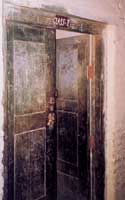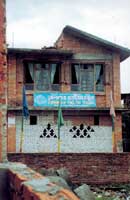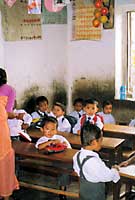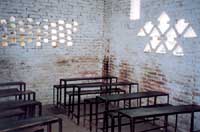|
|
||||
|
A coat of paint to cheer up dreary
schoolrooms. |
||||
|
A kind friend of mine in London donated some money for the Emergency Fund in Nepal – he had already sponsored two children but also wanted to help some of the other children who were still waiting for a sponsor. We have hundreds of these children on our files at «Help in Action» and more still who are waiting to fill out the application form. With this money I was hoping to help some people pay for the operations they needed and also attempt to help as many children as possible – probably by helping the schools. On my return to Nepal this year I was given a large (thanks to the generosity of so many people) pile of new sponsorships to set into motion. This means a check up with the doctor at the Himalayan Healing Centre Clinic, then registering the child into a school and paying for the whole year, buying them school uniforms, books and shoes, and any other necessities that the family might need. We also constantly check up on the children already sponsored to see how they are doing when we distribute the monthly allowance most families get from the money that is left over from the yearly payment. This money ensures that the children have at least a basic meal of rice and dahl (lentils) daily. There are many different kinds of schools here in Nepal. The government schools are not free and the standard is quite low. The English Boarding schools conduct their classes in English and also vary in quality. Many of the schools our children attend are the ones that cost the least because there are usually many children in each family, and so we try to admit two or three of them at once. The schools all concentrate on work – there are few if any luxuries at these schools – sports, music and art are rarely offered. The children learn Nepalese and very basic English and maths. Social studies are also taught. One day I was admitting four children to a school in the area called Wits Academy. The school had only been open for a year and a half, and I found it to be one of the most depressing schools I had seen up until then. The principal however, was very open and willing to listen to my suggestions. I offered to paint the school for him in bright cheerful colours and pay for an electrician to come and install lights in each room – all of which had very dirty stone walls, bare of any decoration, and were crowded with small benches at which the students sat. I felt that this would at least change the environment for about three hundred children and perhaps inspire them all a little. I had brought with me many educational posters and charts from America and planned to put them on the newly painted walls. Work began during the Dashain holidays. The building is actually owned by the assistant school principal, and I persuaded him to invest a little money and effort also, by plastering the brick walls, which had many gaps and proved to be very cold in the winter. I was surprised to see them the next day plastering the walls with cow dung – but they assured me this was the best way and the smell would disappear in a few days, after which the walls would be painted in green and white. We painted the benches in the four colours of the school and I bought lampshades made out of rice paper that the tourists buy in bulk but no Nepalese people have in their homes. I also purchased some dolls made by hand and hung them from the ceiling in the nursery classes I feel it is important to show the children some of the beautiful handcrafted items that are made here and I plan to collect some and display them around the school. I was also lucky to meet with Vera Lucia a Brazilian lady who has been very active in Nepal for many years and is an enthusiastic and wonderful teacher. She wished to start Lama Gangchen’s peace education classes in the schools here, and once again the principal of Wits Academy, Durga Saraswoti, was eager to implement her ideas. One of the items that is sadly lacking in most of the schools are books. There are text books – but picture books that bring so much joy and knowledge to our children in the west- are rare here. There are virtually no books in Nepalese for the very young. After meeting with a local publisher and the principal of the school, we decided to start a visiting library once a month in the large area in front of the school. The first appointment was a great success, over 250 children came to look at books and partake in storytelling, dramatic games and singing. We also distributed crayons and photocopied pictures to all the children, which they enjoyed immensely. Unfortunately, we are not yet able to lend books to the children to take home. We are hoping to expand this project to include as many schools as possible in the area, and we would like to write and translate some children’s stories into Nepalese - even if they are just photocopied at first. Anyone visiting Nepal is asked to bring a few books for this project! Another plan is to invite visiting doctors and dentists from the Himalayan Healing Centre, and also Nepalese social and health care workers, to visit the schools and give talks and demonstrations on topics ranging from basic hygiene, including how to brush your teeth (not practised by the majority of children here); the importance of boiling and filtering water, how to care for young babies and needs of elderly relatives. Many of the children here suffer from a variety of skin diseases and also conjunctivities – and it is hoped that with the right attention paid to them these infections may be curbed. Any help or suggestions for the visiting library would be greatly appreciated and can be sent to «Help in Action». Beverly Bronson |
||||
|
|
||||





